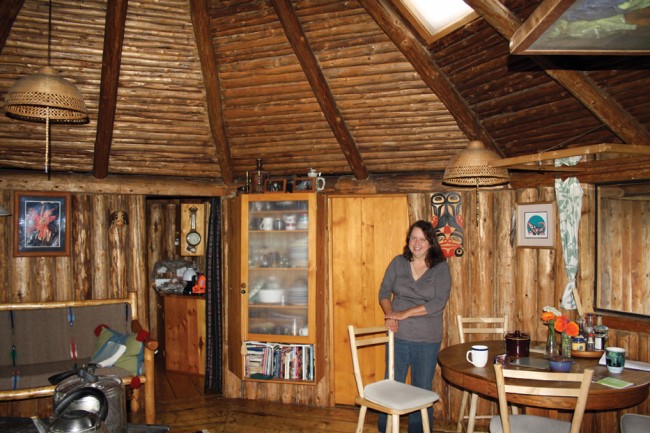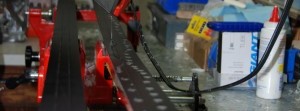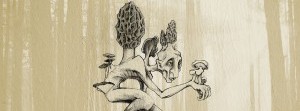
Photo Credit: Norma Kerby
The House that Rick Built: back to the land along the Stikine
After spending the winter of 1972 in a tipi north of Terrace, Rick and Barb McCutcheon were looking for somewhere to set up a permanent homestead.
These were heady days. Young people stretched the limits of imagination and endurance. Similar to their great-grandparents who had settled on the unplowed buffalo plains of the Canadian Prairies, it was a generation seeking adventure and freedom. But, unlike the initial waves of pioneers, they also sought harmony with the world around them. Among the first of the modern environmentalists, the 1970’s back-to-the-landers wanted to learn and do for themselves.
For Barb and Rick, it was a choice between Bute Inlet or the Stikine River. In the early 1970s, Crown land was still available for homesteading in the Telegraph Creek area of northern BC, along the Stikine. Attracted by the beautiful landscape and the friendliness of the people, Barb and Rick settled into Glenora, down-river from Telegraph Creek.
Glenora had been a staging point for stampeders travelling to the Klondike Gold Rush of 1897-98. At one point, more than 10,000 people waited at Glenora to move inland to the riches of the Yukon. By 1971, Glenora had long been a ghost town, the only driving access to the rich, grassy river-side flats being a rough and winding road from Telegraph Creek. With fertile soils and an established outfitter’s ranch across the river, Glenora was attracting young people who wanted to live in its challenging wilderness.
I had met Rick and Barb McCutcheon through a series of friends when they had volunteered to be part of our northwest BC amphibian monitoring program. We leapt at the chance to have a monitoring location in the Stikine Valley, northern-most limit for many cold-blooded species. Not only were Rick and Barb situated the furthest west that one can drive down the Stikine, they also conveniently had one of the most remote and beautiful bed-and-breakfast locations I have ever seen. Even the name, “Up The Creek B&B,” suggested that this would be a rather unusual situation.
Just the right place
“So how long did it take you to locate such a spectacular spot?” Between mouthfuls of fried salmon, I had been listening to the fascinating story of how two young people found themselves in this remote location.
Rick looked at me carefully, thinking back to the days he spent wandering along the mining trails in the Glenora area, seeking a spot where the land and the topography worked for him. “About half a year,” he finally said. Compared to most of the other young couples, he did not choose to build close to the river. Instead, he searched uphill until he found a south-facing birch slope with rich black soil and plentiful water. No electricity, no heavy equipment, no lumber available to build a house—he would need somewhere with trees close at hand for a log cabin. Mid-slope, the homestead would be above the winter’s cold air drainage into the valley bottom. Facing south, a gentle slope would warm first in the spring and provide better growing conditions for gardens in this far northern location.
“But how do you build a big house in the middle of nowhere with only hand-tools?” The solution was elegant. Logs laid lengthwise are long and heavy, difficult to move, and problematic as the walls get higher. Vertical logs laid side-by-side in one- to three-meter lengths can be handled by one person, but the bearing strength of long walls made from short vertical logs is not great. The solution was to make an octagon.
Eight-sided structures have been used for centuries in Europe. Efficient to build, easy to heat, and with lots of useable internal space, octagons work well for dairy and livestock barns. An 1879 book on barn construction speaks highly of the circular stone buildings of the Shakers and of the American octagonal barn. These buildings could be more than 30 meters across. As explained in the book, in an eight-sided building, “each side bears equally upon every other side, and has great strength without cross-ties or beams.”
With only hand tools, and using the white spruce from the slope around him, Rick built an octagonal house out of vertical logs. To construct the roof, he used radiating rafters which expanded like a fan down to meet the walls. Held together at the top by a kingpin, these rafters were covered with slender poles cut to length then sheathed with sheet-metal roofing. A central wood stove heated the entire house without leaving any cold corners. Made from thick, hand-hewn boards, even the floor was built to keep the cold at bay. As their family expanded, Barb and Rick added a pentagon to serve as a master bedroom, and another octagon for the children, making a honeycomb home of strength and functionality.
A life well lived
Forty years later, the house is a work of ingenuity and art. Distracted by all the hand-made attractions, we forgot about looking for wood frogs and toured around the farm. The hand-made bent sapling furniture was outshone by the hot water heater—hose coiled inside a solar-collector box. Even the deep-freeze was hand-made: two marine cooling units, originally intended for a yacht, embedded in a thick wooden box big enough to store an entire moose. Where does the electricity come from to run this? One of the few modern touches is a set of solar panels on the roof; banks of batteries allow the McCutcheons to join the electronic world like the rest of us.
Sipping Barb’s herbal tea and warmed by the home-fabricated wood stove, we talked about the early days of their lives up the Iron Road. In the winter, the only way out was by dog-sled. There were at least 10 other families living in Glenora in those days; people shared and visited. With the closest store two hours away in Telegraph Creek, everyone grew a big garden, canned, preserved, made clothes and crafts, worked together to make a community.
Today, Barb and Rick are one of just several families left along the Iron Road. Few people are willing to work as hard as they have to live in the wilderness. As I watched them, I couldn’t help but think of my grandmother’s saying about a life well lived.
Recently, a young couple has moved into the area. They spend a lot of time at Barb and Rick’s place, asking how to make things.
If you are interested in contacting Rick and Barb or learning more about their B&B, contact them at rickandbarb@telegraphcreek.com.






A quick question. I’m researching a book about Mike Oros who I know had a particular interest in Glenora, and who built octagonal cabins. He lived as a young man in Kansas, where octagonal barns and homes were common in the nineteenth century.
As you’ve been in Glenore since 1972, and built your octagonal home there in the years he was in the area, I wonder if Mike ever discussed octagonal cabins with you? If so, please respond, when you have time - I know this is your busy season.
I used to live in Atlin, and have been to Glenora; now I live on Salt Spring Island.
Thanks,
Martin
👤 Martin 🕔 Jul 15, 2016
Hi Martin.
Here’s what Rick said in response to your question: “No we never met Mike Oros but heard a lot about him. I did see one of his cabins at Shesley which is part way to Atlin. It is an octagon with horizontal logs and a cribbed roof. It is still standing but in poor shape.”
👤 joanne 🕔 Jul 20, 2016
It looks so cool. I would love to have the same house. I was wondering how long it took you to build it. It was so amazing that with just the use of hand tools you were able to build an awesome place like that. And the location is really perfect for that kind of house. I know someone who work for an Interior design company named EMA Architecture and they also build architectural designs that would fit your budget, sense of style and needs. If you want to check them out. you can visit them here . Thanks for sharing this awesome article with us. I will shoot you an email to get in touch with you in the following weeks.
👤 Travis 🕔 Feb 03, 2017